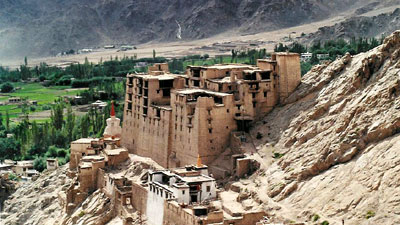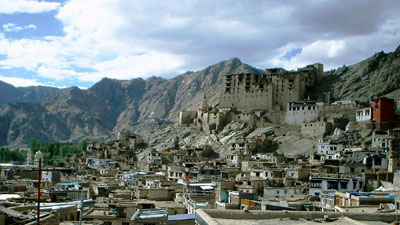About Ladakh
Ladakh is a high altitude mountainous region bounded by the Karakoram Range from the north and the Great Himalayas in the south. Often described as ‘Moonland' on account of the unique lunar landscape, Ladakh abounds in awesome physical features set in an enormous and spectacular environment. For close to a millennium, the region was an independent mountain kingdom of strategic importance. Leh, the royal capital, was a major crossroads of Asia and a stopping point on the ancient migration routes of the trans-Himalayas, connecting Central Asia with the Indian sub-continent. From here, the old caravan routes led westward through Kashmir to the Silk roads, northward across the Karakorum Pass to Central Asia, eastward across the Chang-thang highlands to Tibet and China, and southward through present-day Himachal Pradesh to the plains of India.
Many migrants have traveled through Ladakh, some settling on the way, giving a distinctive characteristic to its population - from the west, early Dard settlers and later-day invaders from Baltistan; from the east, Tibetan settlers, invaders and rulers; from the north, traders from Yarkand; and much later, Dogra conquerors from Jammu in the south.


The people who settled here established Ladakh's centuries-old religious and cultural heritage: the shamanistic Bon-po with roots across the Tien Shen to Southern Siberia's Attai mountains, and later, Buddhists from Kashmir some five centuries before Buddhism reached Tibet. The 16th century saw the introduction of Islam to the region and 19th century Moravian missionaries brought Christianity in the region.
For centuries, Silk Road caravans and devoted pilgrims passed through this crossroads, endowing the region with a convergence of religious and artistic traditions, which find expression in the many monuments & Buddhist monasteries that dot the landscape. The fairs and festivals, cultural traditions and lifestyle of the people also reflect this convergence of myriad influences. Shielded by the high mountain ramparts, Ladakh remains an unspoiled enclave of Tibetan Buddhism to date.
At some stage in its history, Ladakh became recognized as the best trade route between India and Central Asia. On this long route, Leh was the midway stop, and developed into a bustling entrepot, its bazaars thronging with merchants from distant countries. In 1834 AD, Gulab Singh, the ruler of Jammu sent his general Zorawar Singh to invade and gain control of this strategic region in the heart of Asia. As a result of his conquest, Ladakh, together with neighbouring Baltistan, was incorporated into the newly created State of Jammu & Kashmir. Just over a century later, the partition of India saw Baltistan becoming part of Pakistan, while Ladakh remained in India as part of the State of Jammu & Kashmir.
General Information
|
Ladakh Environment
Ladakh has a fragile eco-system which sustains, besides the sparse population, some rare fauna and flora which are especially adapted to the peculiar environment. This is aptly described in the document brought out by the WWF (India) under the title “Saving a prized gift” which reads as under:
“For long years, the region had remained relatively isolated and untouched by developments in the world beyond. A unique genetic pool has evolved in the region, specially adapted to the harsh environment. The Indian Wildlife (Protection) Act, 1972 recognizes most of the species found in the region as endangered.”
Among Ladakh's most important fauna are the: Bactrian Camel, Brown Bear, Ladakhi Urial, Lynx, Red Fox, Siberian Ibex, Snow Leopard, Tibetan Antelope, Tibetan Argali, Tibetan Gazelle, Tibetan Wild Ass, Tibetan Wolf, Wild Dog, and the Wild Yak.
And among its indigenous and visiting wetlands birds are the endangered Black-necked Crane and Bar-headed Goose, and the Ruddy Shelduck, Gargeny, Northern Pintail, Northern Shoveller, Eurasian Pigeon, Gadwall, Mallard, and Red-Crested Pochard. Other birds found in the area are: the Golden Eagle, Himalayan Snowcock, Lammergeler, Osprey, Snow Partridge, Sparrow Hawk, Steppe Eagle and the Tibetan Sand Grouse.
And far too many to mention by name are the more than 500 wild medicinal plants - many rare species - used by traditional Ladakhi and Tibetan medical practitioners (Amchi) and in demand by today's pharmaceutical companies.
The Ladakh environment deservers your special care and consideration so that this fragile eco-system is not disturbed to the disadvantage of its unique and endangered wild-life. The following steps are especially recommended to be followed in this regard:
- Do not permit your car drivers to drive off in wildlife areas, particularly on the Chang-thang plateau;
- Do not walk off the main trekking routes ;
- Do not throw any rubbish including clothes, metals pieces, paper and plastics in any safari/trekking area, nor permitting your safari/trekking staff to do so;
- Do not throw any waste in animal burrows (e.g. marmot), or in any waterways.
- Do not camp along lake-sides and marshlands as the tourist season coincides with the breeding season of migratory birds;
- Do not approach, or photograph nesting birds from close distance. Use only long-focal length (telephoto) lenses for photography of such birds, and your camera flash must be turned off
|
|



